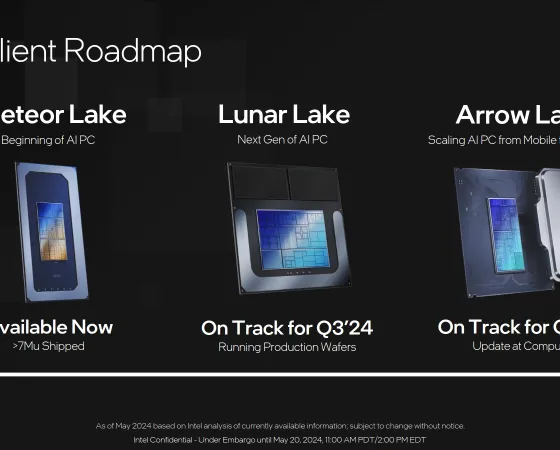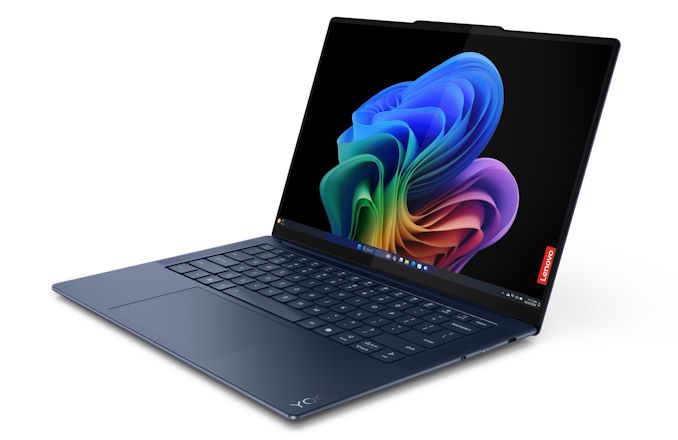Microsoft Paint Is Getting an AI-Powered Image Generator
Read more of this story at Slashdot.
Read more of this story at Slashdot.
Read more of this story at Slashdot.
Read more of this story at Slashdot.
Read more of this story at Slashdot.
Read more of this story at Slashdot.
 La chose est devenue classique : avant le Computex (où votre humble serviteur sera ravi de fourrer sa truffe pour vous dégoter les derniers ragots), les grandes marques organisent des keynotes d’annonces, histoire que leur stand et leurs partenaires aient quelque chose à montrer dès l’ouverture du s...
La chose est devenue classique : avant le Computex (où votre humble serviteur sera ravi de fourrer sa truffe pour vous dégoter les derniers ragots), les grandes marques organisent des keynotes d’annonces, histoire que leur stand et leurs partenaires aient quelque chose à montrer dès l’ouverture du s...
The next few weeks in the PC industry are going to come fast and furious. Between today and mid-June are multiple conferences and trade-shows, including Microsoft Build and the king of PC trade shows: Computex Taiwan. With all three PC CPU vendors set to present, there’s a lot going on, and a lot of product announcements to be had. But even before those trade shows start, Intel is looking to make the first move this afternoon with an early preview on its next-gen mobile processor, Lunar Lake.
While Intel hasn’t said too much about what to expect from their Computex 2024 keynote thus far, it’s clear that Intel’s next-gen CPUs – Lunar Lake for mobile, and Arrow Lake for Mobile/Desktop – are going to be two of the major stars of the show. At this point Intel has previously teased and/or demoed both chips (Lunar more so than Arrow), and this afternoon the company is releasing a bit more information on Lunar Lake even before Computex kicks off.
Officially, today’s reveal is a preview of Intel’s next Tech Tour event, which is taking place at the end of May. Unofficially, this is the exact same date and time as the embargo on Qualcomm Snapdragon X laptop announcements, which are slated to hit retail shelves next month. Lunar Lake laptops, by contrast, will not hit retail shelves until Q4 of this year. So although the additional technical details from today’s disclosure are great to have, looking at the bigger picture it’s difficult to interpret this reveal as anything less than a bald-faced effort to interdict the Snapdragon X launch (not that Qualcomm hasn’t also been crowing about SDX for the last 7 months). Which, if nothing else, goes to show the current tumultuous state of the laptop CPU market, and that Intel isn’t nearly as secure in their position as they have traditionally been.
While we've been expecting the availability of the Qualcomm Snapdragon X Elite processor to be around the middle of this year, Lenovo has announced two new 'AI-powered' notebooks for the Windows on Arm platform. Announced is the Lenovo Yoga Slim 7x Gen 14 and the Lenovo ThinkPad T14s Gen 6 both feature Qualcomm's latest 12-core Snapdragon X Elite processor, ushering in a new era for Microsoft's Windows on Arm platform. Lenovo aims to target content creators and business professionals with these new models.
Qualcomm's new Snapdragon X Elite processor looks set to try to change the adoption of the Windows-on-Arm devices, with a critical focus on providing AI capability on device, which promises up to 45 TOPs of performance solely from the Hexagon NPU. Powered by the Oryon CPU cores, the Snapdragon X Elite is designed to deliver exceptional performance and efficiency, achieving up to 3.8GHz in all-core turbo in intensive workloads. The processor also includes the latest Hexagon NPU, offering 45 TOPS of performance for INT8 tasks, making it well-suited for handling complex AI tasks on devices such as Generative AI.

Lenovo Yoga Slim 7x Gen 14 Notebook for Windows on Arm
Starting with the slimmer of the two models, the Lenovo Yoga Slim 7x is primarily tailored for creators. It is designed to be thin, lightweight, and portable and has a 70 Wh battery, making it ideal for creators on the go. The device is powered by the latest Snapdragon X Elite processor, featuring Qualcomm's integrated Hegaxon NPU designed to power GenAI-based text-to-image capabilities, sophisticated photo and video editing tools, and intelligent text creation and editing feedback.

The Lenovo Yoga Slim 7x Gen 14 is just 12.9 mm thick.
For connectivity, it only uses Type-C, with three USB 4 Type-C ports for the fastest 40 Gbps-capable devices. It also has a single audio jack with an HDMI 2.1 video output. Built into the top bezel is a 1080 webcam with four microphones, and it also supports IP MIPI with an integrated privacy shutter. Additional features include Dolby Atmos audio, while it also comes with Wi-Fi 7 and Bluetooth 5.3 connectivity incorporated within the Qualcomm Snapdragon X Elite processor. It weighs just 1.28 kg, with a slim 12.9 mm profile, making the Lenovo Yoga Slim 7x perfectly light for users on the go.

The Lenovo ThinkPad T14s Gen 6 notebook
On the other hand, the Lenovo ThinkPad T14s is optimized primarily for business users. It is designed to deliver optimal performance and efficiency with the Qualcomm Snapdragon X Elite 12-core processor. As with the Yoga Slim 7x, the ThinkPad T14s uses the integrated Qualcomm Adreno GPU for graphics capabilities, and it powers the 14" display, which can come in 1920 x 1200 IPS or 2.8K with an OLED panel. The on-device Hexagon NPU primarily handles AI inferencing tasks on chips and ensures seamless integration with Microsoft 365 applications. This model is designed to provide robust device management, enhanced collaborations on the go, and integrated chip-to-cloud security for professional environments.
| Lenovo ThinkPad T14s Gen 6 & Yoga Slim 7x 14 Gen 9 Specifications (Qualcomm Snapdragon X Elite Models) |
|||||||
| AnandTech | ThinkPad T14s Gen 6 | Yoga Slim 7x 14 Gen 9 | |||||
| Processor | Qualcomm Snapdragon X Elite Windows on Arm 12C / 12 T Up to 3.8 GHz All-Core 4.2 GHz 2T Boost Dynamic undisclosed TDP |
Qualcomm Snapdragon X Elite Windows on Arm 12C / 12 T Up to 3.4 GHz All-Core 4.0 GHz 2T Boost Dynamic undisclosed TDP |
|||||
| Memory | Up to 64 GB LPRRD5X-8533 2 x 32 GB |
Up to 32 GB LPRRD5X-8448 2 x 16 GB |
|||||
| GPU | Qualcomm Snapdragon X Elite Adreno Graphics | ||||||
| NPU | Qualcomm Hexagon NPU (45 TOPS) | ||||||
| Display | 14" IPS, 1920 x 1200, sRGB, 400 nits 14" IPS, 1920 x 1200, NTSC, 400 nits 14" OLED, 2.8k, HDR5x, 400 nits |
14.5" OLED, 2944 x 1840, 90Hz, Touch |
|||||
| Storage | Up to 1 TB PCIe 4.0 x4 | Up to 1 TB PCIe 4.0 x4 | |||||
| Networking | Wi-Fi 7 Bluetooth 5.3 |
Wi-Fi 7 Bluetooth 5.3 |
|||||
| Audio | Dual Speakers, Dolby Audio | Dolby Atmos | |||||
| Battery | 58 Wh (No battery runtime claimed) | 70 Wh (No battery runtime claimed) | |||||
| Connectivity | 2 x USB 3.2 G2 Type-A 2 x USB 4 Type-C Audio Jack HDMI 2.1 Output |
3 x USB 4 Type-C, PD 3.1, DP 1.4 | |||||
| Dimensions | 313.6 x 219.4 x 16.9 mm (12.34 x 8.64 x 0.67 inches) | 325 x 225.15 x 12.9 mm (12.8 x 8.86 x 0.51 inches) | |||||
| Weight | 1.24 kg / 2.72 lb | 1.28 kg / 2.82 lb | |||||
| Camera | 1080p, IR MIPI /w Privacy Shutter | 1080p, IR MIPI /w Privacy Shutter | |||||
| Color | Eclipse Black | Cosmic Blue | |||||
| Pricing | Starting From $1699 | Starting From $1199 | |||||
On the connectivity front, it has dual USB 3.2 G2 Type-A ports and two USB 4 Type-C ports for the fastest 40 Gbps-capable devices. It also has a single audio jack with an HDMI 2.1 video output. Built into the top bezel is a 1080 webcam with dual microphones, and it also supports IP MIPI with an integrated privacy shutter. Additional features include a fingerprint reader within the power button and dTPM. Lenovo uses the integrated Wi-Fi 7 within the Snapdragon X Elite for wireless connectivity, providing Bluetooth 5.3 support.
The Lenovo Yoga Slim 7x 14 Gen 9 and ThinkPad T14s Gen 6 can support up to 1TB of PCIe 4.0 x4 storage, while memory capability depends on the model. The Yoga 7x 14 Gen 9, a slimmer model, is limited to 32 GB of LPDDR5X-8448 memory in a dual-channel configuration. At the same time, the ThinkPad T14s Gen 6 can accommodate up to 64 GB of slightly faster LPDDR5X-8533 memory.
Additionally, Lenovo offers deployment services through its Lenovo TruScale platform to support the efficient management of next-generation AI PC devices such as these models. These services include customizable security features, tailored deployment processes, enhanced control over the deployment process, and services designed to align with specific business objectives.
Both the Lenovo Yoga Slim 7x and the Lenovo ThinkPad T14s Gen 6 will be available starting June 2024, with the Yoga Slim 7x starting at $1,199 and the ThinkPad T14s Gen 6 priced starting at $1,699.
Read more of this story at Slashdot.
Read more of this story at Slashdot.
Read more of this story at Slashdot.
La semaine dernière, des employés d’OpenAI, dont Ilya Sutskever et Jan Leike, ont quitté l’entreprise, laissant l’équipe de « Superalignement » vide. Mais leur message pour annoncer leur départ était laconique. La raison ? OpenAI imposait jusqu’à présent à ses salariés voulant quitter l’entreprise la signature d’un accord de confidentialité (NDA) à vie, au risque de perdre leurs actions.
Les déclarations des démissionnaires d’OpenAI envers leur ancien employeur étaient plus que succinctes. Ilya Sutskever affirmait ainsi être « convaincu qu’OpenAI construira une AGI à la fois sûre et bénéfique ». Étonnement positif pour quelqu’un quittant l’entreprise. Jan Leike a seulement écrit « « j’ai démissionné ».
Vendredi, OpenAI a finalement annoncé la dissolution pure et simple de leur équipe tout en expliquant intégrer les personnes restantes dans ses autres équipes de recherche « afin d’aider l’entreprise à atteindre ses objectifs en matière de sécurité ».
Le média Vox a trouvé une raison au mutisme des employés : l’entreprise leur a simplement fait signer un accord de confidentialité (NDA) qui leur interdit de la critiquer.
Read more of this story at Slashdot.
Read more of this story at Slashdot.
Minimachines.net en partenariat avec TopAchat.com
Mise à jour du 20/05/2024 : La console AYA Neo Air 1S change de processeur sans changer de nom. Il faut dire que la seule différence entre le modèle 2023 et ce nouveau modèle en 2024 est un passage du Ryzen 7 7840U à un Ryzen 7 8840U qui sont quasiment identique mis à part leur TDP. Le nouveau venu oscille de 15 à 28 watts contre 15 à 25 watts pour le précédent. La batterie pourrait être adaptée en conséquence à moins que Aya décide de brider la pue à 25 watts ?
Billet original du 30/06/2023 : La dernière née des ConsolePC de Aya change un peu la mécanique habituelle. Avec un écran haut de gamme mais de plus petite diagonale, la AYA Neo Air 1S cherche à jouer sur la corde de l’encombrement pour lutter contre la concurrence.

Et ce n’est pas un mauvais pari, d’autant que cette nouvelle venue ne semble pas vouloir démériter sur la performance proposée. En choisissant un excellent processeur AMD Ryzen 7 7840U, la AYA Neo Air 1S proposera les mêmes capacités que la majorité de ses concurrentes. Elle le fera simplement dans un engin au châssis plus facilement transportable.
L’écran choisi utilise une dalle AMOLED pour proposer un FullHD raisonnable dans ce type de diagonale. Avec son processeur qui embarque un circuit graphique Radeon 780M, les capacités d’affichage seront excellentes en 1920 x 1080 pixels. La densité de pixels atteindra 404 pixels par pouce et les caractéristiques de la dalle seront assez évoluées : 350 nits de luminosité, et une colorimétrie contrôlée proposant 100% du spectre sRGB, et 96% de l’Adobe RGB. En clair, Aya a choisi une dalle plus que correcte pour démarquer sa petite console.

La puce déployant 8 cœurs Zen4 et 12 RDNA3 sera accompagnée par un montant inconnu de mémoire vive en LPDDR5x. Et donc soudée à la carte mère. On ne connait pas ce montant, ce qui signifie que Aya n’est pas encore très sur de lui sur ce poste. J’imagine que suivant les négociations on retrouvera ici de 8 à 32 Go de mémoire vive. Difficile de justifier plus ou moins. A mon sens 16 ou 32 Go sont parfaitement adaptés à cette solution, le partage de la mémoire système avec le circuit graphique ayant un impact sur les performances globales, les 8 Go sont un peu maigres au vu du cours actuel de la mémoire vive.

Le stockage est monté sur un slot M.2 2280 non identifié. Là encore je doute que le choix d’autre chose qu’une solution NVMe soit retenue. Les prix de ces stockages sont désormais plus bas que leurs homologues en SATA 3. On ne connait pas les montants de ce stockage. Là encore le choix entre des solutions 256/512 Go semble logique même si les constructeurs sont désormais habitués à proposer des machines avec de grosses capacités sur leur haut de gamme.

Un lecteur de cartes MicroSDXC permettra d’étendre le stockage de la console facilement. On retrouve également deux ports USB4, un port jack audio combo 3.5 mm et un module Wi-Fi6E et Bluetooth 5.2.

Le tout entre dans un châssis de 22.4 cm de large pour 8.95 de haut et 2.16 cm d’épaisseur. Un petit gabarit très dense qui porte son poids à 450 grammes et permet d’embarquer une belle collection de fonctions. C’est vraiment l’argument phare de la console puisqu’il promet une meilleure portabilité que l’ensemble des solutions concurrentes actuelles.

Face à la console de Valve, la AYA Neo Air 1S propose une toute autre portabilité. L’engin est moins large et moins haut et pourra plus facilement vous suivre tout au long de la journée.

Même chose face à la ROG Ally d’Asus. La nouvelle venue est beaucoup plus compacte et portable. Bien entendu cette limitation de poids et de taille pose question. Aya assure être arrivé à proposer une ventilation équivalente en température… mais on ne sait pas si cela se fait au détriment du confort à l’usage. Si la console parvient à rafraichir sa puce en échange d’une ventilation bruyante ou non. Autre questionnement, quel impact cela aura sur l’autonomie de la console ? Combien d’heures de jeu seront réellement atteignables avec ce gabarit. Si l’engin est plus portable mais ne propose que l’ombre de l’autonomie de ses concurrentes, cela n’a pas grand intérêt.

Pour le reste, on retrouve une belle panoplie de fonctions avec un capteur 6 axes servant de gyroscope, un moteur de vibration, une paire d’enceintes stéréo et une panoplie de contrôleurs complète pour une bonne jouabilité. Double joystick à effet Hall, gâchettes également analogiques, boutons ABXY et croix directionnelle. Le tout fonctionnera sous Windows 11 et la marque promet une surcouche logicielle de pilotage baptisée AYA Space 2.0 pour profiter au mieux de la console. On note aussi la présence d’un lecteur d’empreintes sur le bouton de démarrage pour s’identifier facilement et retrouver des sessions et des bureaux différents suivants les utilisateurs.
Je vous propose le lien vers la vidéo de 53′ présentant la console mais elle est malheureusement difficile à suivre. Elle débute réellement à 11’30 et le patron de Aya y parle en chinois avec une traduction en Anglais par dessus qui rend l’ensemble parfois difficile à suivre. Mais si ce modèle vous intéresse vraiment, vous pourrez y retrouver des informations supplémentaires.
AYA Neo Air 1S : le console 5.5″ AMOLED évolue vers le 8840U © MiniMachines.net. 2024.
